|
< Earlier Kibitzing · PAGE 1 OF 2 ·
Later Kibitzing> |
| Apr-11-03 | | Ashley: Two players I did not see in the best of the 20th Century articles. However, they must have both been close. |
|
| Apr-11-03 | | Kenneth Sterling: They are both in my top ten. |
|
Jun-21-04
 | | LIFE Master AJ: <Reply to both>
These players were easily two of the strongest players of the 20th Century. |
|
| Mar-24-07 | | Whitehat1963: Is there no win possible for white sometime after 30...h6? (Player of the Day plays Opening of the Day) |
|
Oct-25-09
 | | wwall: After 32...g5 33.Rc6 draws. Perhaps White could try 33.h3 or 33.Bd1 if he was trying to play for a win. |
|
| Feb-20-10 | | waustad: What an instructive way to force the draw. |
|
| Jan-25-18 | | tgyuid: there's something very very pretty about the way this smyslov character plays the game.... |
|
| Jan-25-18 | | tgyuid: beautiful |
|
| Jan-25-18 | | john barleycorn: thanks for pointing this game out. yes, a real pleasure to replay it. |
|
| Jan-25-18 | | tgyuid: 2...d5!, i should have said; just so excited though;; i mean there's a complete history of the universe in the first three moves of this game |
|
| Jan-25-18 | | tgyuid: the euwe- alekhine world championships featured the slav alot, you see; but as arrives from 1...d5; here smyslov takes advantage, we might say, of the triksy horse offering less information to modulate from the english; its an advance |
|
Jun-30-21
 | | GrahamClayton: Reshevsky can only draw with a K + B, so as long as Smyslov removes the White pawns, a draw results. |
|
| Jun-30-21 | | RookFile: You get the feeling that Smyslov had deep opening prep going into this game. |
|
Feb-26-22
 | | KEG: Smyslov was, in addition to being a great player, always a problem for Reshevsky. Reshevsky won their first classical game back in 1939, which was an informal encounter, and then did not win single game against Smyslov until 1970. Smyslov won both games against Reshevsky in the 1945 USA-USSR Radio Match, won one and drew four in their games at the 1948 World Championship Tournament, and won one of their two games at the 1953 Zurich Challengers' Tournament. As <RookFile> notes here, Smyslov came well- armed for his games against Reshevsky, and was one of the very greatest end-game players of all time (as Botvinnik learned twice in this tournament and as Fischer learned when he tried to win a favorable endgame against Smyslov at Monaco 1967). I agree with the comments on this site about Smyslov and Reshevsky being among the all-time greats. Smyslov has to be in the top ten, and Reshevsky--at a minimum--has to be considerd to be among the two or three finest American players, at least in terms of his results (and might have been the best if not for Fischer). In this 6th round game from the 1948 World Championship Tournament, both players came well-prepared (even Reshevsky, who generally was no book-worm). The opening itself here is a classic, as <tgyuid> has pointed out. To note just one feature, Reshevsky allowed Smyslov to crank out a Bishop sacrifice that netted at one point four pawns, having a tricky move-10 novelty in mind. Smyslov, however, was prepared for even that, and a thrilling back-and-forth battle ensued. The play here was not always perfect, but was at a very high level. Both players had a significant edge at one point, and both had to navigate tricky situations to survive when they got in trouble. All in all, a fascinating game to play over and attempt to analyze. 1. d4 Nf6
2. Nc3 d5
What opening would this be? Each player was holding his cards close to his vest at this stage. The possibilities were endless. Perhaps Reshevsky would play 3. cxd5. 3. d4
Nope, Reshevsky was willing to play a Queen's Gambit. But was Smyslov intending to make this a Grunfeld Defense by playing 3...g6? 3... c6
Nope. So now we have a Slav.
4. Nf3
According to Keres, 4. e3 was more popular at the time since it avoids sharp retorts from Black. 4. cxd5 was also, says Keres, an excellent option. But Reshevsky, as will be seen, wanted to enter complicated waters. One imagines that he wanted revenge for what Smyslov did to him in the 1945 radio match in which he thoroughly out-prepared Reshevsky (who discovered in one game that Smyslov had only used one minute for a complex ans lengthy opening variation for which Reshevsky had to use much of his time). 4... dxc4
"Certainly simpler than 4...e6...Smyslov has now obtained his favorite position, which he has investigated thoroughly in his home analyais, and where he normally displays exceptional inventiveness." (Keres) In this case, however, Reshevsky had some home cooking up his sleeve as well. 5. a4

click for larger view"Reshevsky played 5. e3 against the same opponent in the 1945 USA-USSR radio match and had a bad time (he lost). However, 5. e3 is not inferior to the more customary text move." (Kmoch) Kmoch notwithstanding, Reshevsky's move poses more problem for Black than the safe, solid, equalizing 5. e3. However, Reshevsky surely knew that Smyslov would be well-prepared for 5. a4, as he was. Keres summed the situation up nicely:
"In the radio match-game Reshevsky chose the continuation 5. e3 b5 6. a4 b4, but did not get anything from the opening, and later he was worse. The text-move is more common and gives Black more difficult problems." 5... Bf5
6. Ne5

click for larger viewThis and 6. e3 are the usual choices. Opinion was split at the time concerning the respective merits of the two moves: "6. e3 gives White more chances of retaining the initiative." (Golombek) "This divergence is by no means inferior to the more usual [sic] 6. e3." (Kmoch) "This move was often used earlier...But in recent time...6. e3 has been preferred...But for this game Reshevsky has brought out an old variation...with which he hopes to surprised his opponent. But in fact the situation turns out to be the opposite..." (Keres) |
|
Feb-26-22
 | | KEG: Post II
6... e6
The formerly popular 6...Nbd7 went out of fashion after the 1st game of Alekhine's return World Championship match against Euwe in which Alekhine--though winning the match decisively--was beaten by a an innovation by Euwe on move 14, though it is doubtful that 6...Nbd7 was truly the culprit: 6...Nbd7 7. Nxc4 Qc7 8. g3 e5 9. dxe5 Nxe5 10. Bf4 Nfd7 11. Bg2 Rd8 [11...f6 would have been better, but Alekhine need not have lost even after 11...Rd8] 12. Qc1 f6 [12...Be6 was slightly better, but even now Alekhine was not in bac shape) 13. 0-0 Be6 14. Ne4 . Keres called 14. Ne4 "the innovation of the match" and Euwe himself stated that after this game that "I did not succeed in finding a way to meet this move, and it seems that Alekhine did not find any either. Therefore we both avoided this variation when we had the Black pieces." According to Keres, after Alekhine lost the game where he played 6...Nbd7 and got creamed after 14. Ne4! 6...e3 was played in that match "and the general conclusion was that Black thereafter gets a fully satisfactory game" Smyslov was apparently amongst the many who shunned 6...Nbd7 after Alekhine's debacle in game ! of his 1937 match and returned to the older 6...e6 that had been favored by Boguljubov but itself abandoned after Boguljobov's lack of success with the move in his 1929 match against Alekhine. But, all that being said, 6...Nbd7 remains entirely sound. This was simply a case of a famous player losing with a specific opening move and the chess world deciding the move is bad and abandoning it. In the case of Smyslov, however, there is perhaps a bit more to the story, since he developed a profound understanding of 6...e3, as Reshevsky was soon to learn in this game. 7. f3
More fall-out from the 1937 Alekhine-Euwe match In Game 2 of that match, the players--with colors reversed--repeated the early moves, but this time Euwe, as here, played 6...e6 and got a good game after Alekhine played 7. Bg5 and Euwe responded 7...Bb4 (which Alekhine called "much more logical and better than 7...Be7 as played by Bogoljubov in our fifth match game in 1929" [actually, the simple 7...h6 looks best of all--KEG] and the Game 2 of the Alekhine-Euwe 1937 match continued 8. Nxc4 Qd5 (stronger were 8...0-0 or 8...h6---KEG) and now Alekhine erred with 9. BxN instead of 9. Ne3 (which Alekine erroneously said was "even less promising") or, better yet. 9. Qb3. QxN leaving Euwe with the somewhat better chances. Apart from the above history--which I only recount to convey the lines known to the players in selecting their moves in this 1948 game. The position was now (after 7. f3):
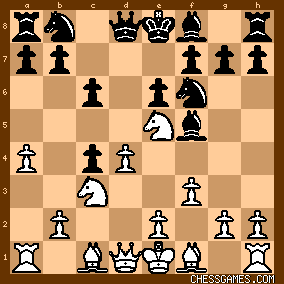
click for larger view7... Bb4
Smyslov here carefully avoided the seemingly obvious 7...c5 with which Bogoljubov got into trouble (though he drew the game) in Game 3 of his 1929 match against Alekhine; e.g. 7...c5 8. dxc5 [This move should have been harmless, White could have secured much the better game with 8. e4---KEG] QxQ+ [Bogoljubov would have done better with 8...Nfd7--KEG] 9. KxQ Bxc5 [once again, Bogoljubov could have improved with 9...Nbd7] 10. e4! [Alekhine knew what to do here] Bg6 11. Bxc4 Nc6 [11...a6 was a good alternative--KEG] 12. NxN bxN 13. Bf4. Even at the end of the above line, Black's chances were not all that bad. But opening theory by 1948 had concluded that 7...c5 was bad, and Smyslov here followed the prevailing opening wisdom. After 7...Bb4, what proved to be the pivotal moment of the game had arrived, the position being: 
click for larger viewBoth players had clearly thought through this position well before the game, and reached opposing conclusions. White can of course simply play 8. Nxc4 (which Keres called "the standard move") and enjoy some small opening edge. Keres claimed that 8. Nxc4 "would have given rise to an interesting position, rich in possibilities. But there were other possibilities here which I will discuss in my next post on this game. |
|
Feb-27-22
 | | KEG: Post III
Golombek and Kmoch, in their commentaries on this game, suggested 8. Bg5, but Keres rightly concluded that this gave White no opening advantage at all after 8...h6 [if anything, Black is better--KEG]. Golombek and Kmoch base their diagnoses on flawed analysis. Golombek gives (after 8...h6) 9. Bh4 (which certainly seems best) c5 10. dxc5 but then only considers the weak 10...Qd5? for Black (after which White does obtain a significant advantage) but overlooks 10...Qa5! after which Black is absolutely fine. Even worse, after 10...Qd5? 11. QxQ Golombek gave the manifestly inferior 11...NxQ recapture instead of the far better 11...exQ. This position is even worse for Black than Golombek displays, since after 12. 0-0-0 g5 Black should play 13. Bf2 rather than Golombek's weaker 13. NxN. Kmoch's analysis of 8. Bg5 is even worse, since after 8...h6 he gives the weaker 9. BxN and insists now that Black's best is the very bad 9...gxB which in fact yields approximate equality and repeats what was then apparently the incorrect notion that the far better 9...QxB gives White a good game. I will spare readers here the errors in Kmoch's subsequent analysis. The conclusion, seemingly, is that Keres' 8. Nxc4 was best. But Reshevsky had a completely different idea:
8. e4?!

click for larger viewOn paper, this looked like a poor choice by Reshevsky: "It is not easy to understand wht Reshevsky is going for this line, which allows his opponent to make a piece sacrifice that, according to theory, will yield him at least a draw." (Euwe) "Theory considers this move as unfavorable for White, as with the following piece sacrifice Black gets material compensation, and also a dangerous attack." (Keres) But perhaps there was a kicker here:
"A surprise since the following sacrifice is considered to give Black at least a draw. But Reshevsky has an innovation in mind." (Kmoch) 8... Bxe4
"!"--(Kmoch)(Euwe)(Keres)
"As known." (Euwe)
9. fxB Nxe4
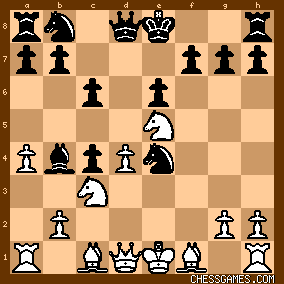
click for larger view10. Bd2

click for larger view"Reshevsky's 'novelty' which, however, has long been known to theory." (Keres) "I have seen this move only once [in fact it had been played on at least two previous occasions--KEG] before in a game, Enevoldsen--Piazzini, Buenos Aires team tourney, 1939 (it ended in a draw too)." (Kmoch) The older line (10. Qf3) is manifestly inferior to Reshevsky's move, e.g. 10. Qf3 Qxd4 11. Qxf7+ Kd8. Here, as Kmoch pointed out, 12. Qxg7?? loses instantly to 12...BxN+ (since if now 13. Ke2 QxN is murder) as in Przepiorka--Cheron, The Hague 1928. Keres claims that 12. Bg5+ leads to an approximately equal game as in Vidmar--Mikenas, Prague 1931, but in fact, Black is better if he plays 12...Kc8 (as did Mikenas). Kmoch says that 12...Kc8 was a mistake and that White now can obtain the advantage with 13. Qxe6+ (instead of Vidmar's weak 13. Bxc4? which should have lost him the game) but Black seems clearly better after 13...Nd7 14. QxN+ QxQ 15. NxQ NxN (and not 15...NxB? which loses) 16. bxN Bxc3+17. Kd1 BxR 18. Nc5 b6 where Black has Rook and at least two pawns for White's Bishop and Knight. In the above line, 12...NxB, the only move analyzed by Kmoch and Golombek, leads to approximately equal chances with perhaps a slight edge for Black after 13. Qxg7 Qe3+ (better than Golombek's 13...BxN+ which leads to an even game) 14. Kd1 Rf8 15. Nxc4 Qc5 16. h4 Nf7 17. Kc2 BxN 18. bxB Nd7. All in all, Reshevsky's nearly novel 10. Bd2 looks clearly best from a theoretical perspective, and certainly to the extent is may have been a surprise, since, as will be seen, there is a trap prepared with the text. But there was one problem for Reshevsky: Smyslov was prepared to the hilt for 10. Bd2, as can be seen from the fact that he only devoted 8 minutes for the first 13 moves of this complicated game. |
|
Feb-27-22
 | | KEG: Post IV
10... Qxd4
As Golombek, Kmoch, and Keres point out, the plausible looking 10...Qh4+ could lead to trouble for Black after 11. g3 Nxg3 12. hxN [and not Kmoch's 12. Nf3? which leads only to equality after 12...Qh5 13. Rg1 NxB 14. KxN) QxR 13. Qg4. Golombek overstates White's chances, stating that White now has a win, but Keres' more accurate assessment ("White has a strong attack") is spot on, as shown by the following variation: 13...Nd7 14. Qxg7 0-0-0 15. NxN KxN 16. Qxf7+ Be7 17. Bg5 Rde8 leaving a dreadfully complicated position where White is certainly better but claiming anything close to a win seems preposterous. In any case, the well-prepared Smyslov avoided all of this with his careful 10...Qxd4. 11. NxN
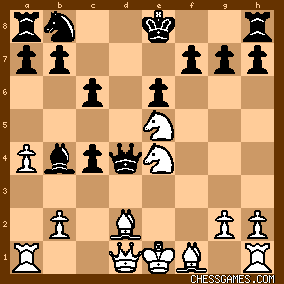
click for larger view11... QxN(e4)+!
In the earlier Enevoldsen--Piazzini game, Black played the far inferior 11...BxB+ and could have gotten into trouble: 12. QxB QxN(e5) [White is also better after 12...QxN (e4)+ 13. Qe2 QxQ+ 14. BxQ]. But here White played the weak 13. Qe2 and the game was about even after 13...0-0. Instead, White would have been better with Golombek's 13. 0-0-0! In the above line, perhaps even better for White is Keres' suggested 12. NxQ , e.g., QxN+ 13. Be2 with White now being clearly better situated. But yet again, the prepared Smyslov side-stepped all these problems with the accurate text. Play then continued:
12. Qe2 BxB+
13. KxB
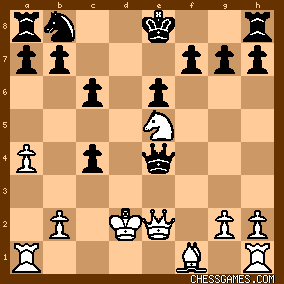
click for larger viewHere again, Smyslov found the best move:
13... Qd5+
There were all sorts of ways Smyslov could have gone wrong here. "Naturally not 13...QxQ+ 14. BxQ and Black loses back a pawn, when White's active pieces would assure him an edge." (Keres) Also inferior would have been 13...Qf5+ (as pointed out by Golombek), e.g. 14. Qe3 QxQ+ 15. KxQ b5? (15...Nd7 or 15...Ke7 would be better but Black would still have the manifestly inferior game) 16. axb5? (Golombek overlooked that White can slowly develop beginning with 16. g3 and probably obtain a won game) cxb5. The balance of Golombek's analysis is laden with flaws which--for our purposes here--are besides the point which is that Smyslov was armed to the teeth for Reshevsky's "novelty" which might have easily felled a less super-prepared opponent. 13...Qd4+ was also OK, but inferior to Smyslov's accurate play. After thirteen moves had been played, the times expended tell much of the tale: Reshevsky: 0:12
Smyslov: 0:08
As is obvious, both sides had done their homework. After 13...Qd5+, the position was:

click for larger view14. Kc2
Contrary to what Golombek claimed, 14. Kc3 would not have been a mistake. But Reshevsky's move does appear to be most accurate. 14... Na6
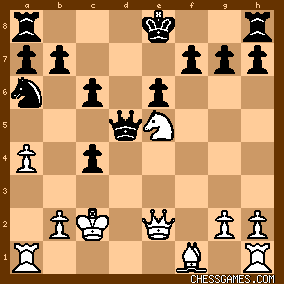
click for larger view"Black has four pawns for a piece in an excellent position. It is hard to believe that White is enjoying this game." (Euwe) I beg to differ. The Black c4 pawn is hanging and the chances in this seriously complicated game are hard to assess. I note in this connection that this precise position was reached no fewer than four times as White by both Karpov and Shirov, and a full eight times by Kramnik. Indeed, Kasparov had White here on one occasion. Thus there is nothing horrific about White's position. I would expect the better played--whether White or Black--to win this game much of the time. Reshevsky did get into trouble here, but that was to a large extent because of his next few moves, as I will discuss in my next post on this game. |
|
Feb-27-22
 | | KEG: Post V
15. Rd1
This was a novelty at the time, and not a good one, though of the commentators, only Keres spotted this error. Either 15. Re1 or 15. Nxc4 (Keres' suggestion) were better. Golombek claimed that 15. Nxc4 was a mistake since Black would then get an irresistible attack." But his line does not support his claim: 15. Nxc4 Qf5+ (in fact, 15...Rd8 was best, and even 15...0-0 was better) 16. Kc3 0-0-0 (16...Qc5 would be better and yield approximate equality) and now with 17. Qe3 or 17. Qe5 White would certainly not be worse. The only cogent analysis I have seen of White's 15th move is that of Keres: "White sacrifices yet another pawn without being able to exchange Queens. Hence the simple 15. Nxc4 looks better." Keres also pointed out that if 15. Nxc4 0-0-0 (hardly best--KEG) then "White plays 16. Qe3, completing his development and threatening to generate a dangerous attack on the King. Lastly, Keres noted that 15. Qe3 would be bad for White in light of 15...Nb4+, though he here only considers the grossly inferior 16. Kc1? for White (16. Kc3 is essential) after which White is in trouble after Keres' 16...Rd8 and in even bigger trouble after the even better 16...0-0-0. 15... Qa5!
More accurate play by Smyslov. If instead 15...Qc5? then, to quote Golombek: "White gets his King into safety by 16. Kb1" and would suddenly have somewhat the better chances. The position after 15...Qa5 was:

click for larger view16. Nxc4?
Although not mentioned by any of the commentators, White had no time for this capture and had to seek shelter with 16. Kc1 or 16. K1. After the text, the situation became critical for Reshevsky. 16... Qxa4+
17. b3
White would also be in serious danger after 17. Kb1 Nb4! as stated by Golombek. After 17. b3, another critical moment in the game had been reached, the position now being: 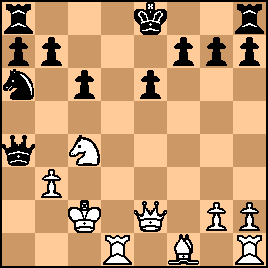
click for larger view17... Qxa2+?
To this point, Smyslov had played magnificent chess. But here he erred and the game shifted course drastically. Correct was 17...Nb4+ 18. Kc3 Nd5+ which would have left: 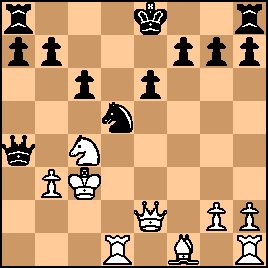
click for larger viewHere, White's only saving move would be 19. Kb2. If instead 19. Kc2 Qa2+ wins and if 19. RxN Qa1+ spells fini for White. After 19. Kb2 Qb4 White's best chance would lie in 20. Qd2, though even then Black need not trade Queens and would have excellent winning chances after 20...Qe7. Returning to the actual game after Smyslov's 17...Qxa2+ 18. Kc3 (forced) QxQ (forced)
19. BxQ
This left:

click for larger viewTime to take stock:
"Reshevsky has a piece against four Pawns, a bad business for White, one would say. But White has a much better development and the Black Pawns are split into two groups, each forming a majority of two Pawns only. Under these circumstances there is little chance that Black's Pawns will become dangerous quickly. On the other hand, to pin down four Pawns with Bishop is so difficult that White cannot hope to do more to maintain the balance." (Kmoch) Kmoch's comments notwithstanding, Reshevsky now made a determined effort to win the game, and the ending soon became very complicated and entirely fascinating. |
|
Feb-27-22
 | | KEG: Post VI
In addition to being a superb endgame player, Smyslov had great resiliency. Having had excellent chances to try to press for a win before his accident on move 17, Smyslov now had to re-group and figure out how to hold the game. Some players become distracted under such circumstances and fail to adjust their strategies and priorities. Smyslov, however, was a cool customer and was able to switch gears and make sure he held the game. There were dangers now. To quote Euwe: "Now White is even slightly better, since Black is unable to prevent the loss of one or two pawns in the long run. The White pieces will soon start exerting strong pressure on the Black position." Reshevsky was an especially dangerous opponent in positions of this sort, and it could be anticipated that he would discover tactical and positional resources to try to undermine the Black King-side and (primarily) Queen-side formations. It is instructive to watch how Smyslov handles the threats Reshevsky summoned in his efforts to prevail. As will be seen, there were many junctures at which Smyslov could have faltered. 19... Ke7
"To meet the threat of Nd6." (Golombek)
19...Nc5 looked tempting, but Reshevsky would then have made head-way with 20. Nd6 Ke7 21. b4. Smyslov spent 50 minutes on this move, while e posi spent 58 minutes on moves 14-19. This left the clocks at: Reshevsky 1:10; Smyslov 1:15. Both sides obviously recognized the dangers and complexity of the position. After 19...Ke7, Reshevsky was at the cross-roads: 
click for larger view20. Na5!
"!"--(Kmoch)(Euwe)
"Quite correct." (Euwe)
Reshevsky spent 20 minutes on this move.
This presents more problems for Black than would 20. Nd6 (which Keres said was "also strong" but Euwe said would have been "less clear"). Had Reshevsky chosen this latter move, best for Black would be 20...b5. Once again, Nc5 looks tempting, but this could have led to an even more difficult position for Black to defend after 21. b4! (21. Rhf1 would also be strong) and then--following the line given in Golombek's commentary--Na4+ (21...Nd7 is another option--KEG) 22. Kb3 b5 (or maybe 22...Nb6) 23. Bf3 Rad8 24. Nb7 RxR 25. RxR Rc8 (basically forced) 26. Na5 Rc7 (not Golombek's 26...c5 that loses to 27. Nc6+) and Black will have a hard time holding after 27. Rc1. After 20. Nd6, Smyslov would doubtless have found the superior 20...b5 and would almost certainly have held the draw after 21. Bf3 (White's best try) Rad8 (Golombek's move) 22. Nb7 (this is the move recommended by Golombek, Euwe, and Keres, though 22. Ra1 is probably White's strongest try here, though Black can probably defend with 22...Nc5 23. Ne4 NxN+ 24. BxN Rd7 (indirectly defending the Black c-pawn, at least temporarily) RxR 23. RxR ("and Black loses a pawn"--Keres) Rc8 24. Ra1 (not 24. Na5 Nb8 and Black is safe--Golombek) Nb8 25. Rxa7 (this move given by Golombek and Euwe seems to let Black off the hook, whereas 25. Nc5 or 25. Kb4--which I would bet Reshevsky would have tried--would have given Black more problems to solve) Rc7 and Black should be able to hang on with his three pawns for the piece despite White's still scary-looking attack. After Reshevsky's 20. Na5, the position was:

click for larger view20... Nc5!
"The counter-threat 21...Ne4+ followed by 22...Nf2 enables Black to escape the demolition of his Queen-side Pawns--at the cost of a pawn, however." (Kmoch)(see Keres and Euwe similarly) The alternative, 20...Nc7, would have given Reshevsky a bit more scope to try to tighten the noose, e.g. (following Golombek's analysis) 21. Nxb7 Nd5+ 22. Kb2 a5 23. Nc5 and White has some pressure. But perhaps we can improve on Golombek's line after 20...Nc7 with 22. Kd4 after which Black will have to struggle to hole the game, e.g., 22...f6 23. Kc5 Nc3 24. Rde1 NxB 25. RxN after which, though Black can perhaps still save the game, his task would not be a pleasant one. The above lines show the merits of Smyslov's 20...Nc5, which left the position as follows: 
click for larger view |
|
Feb-27-22
 | | saffuna: < "...the Black Pawns are split into two groups, each forming a majority of two Pawns only. "> Black has seven pawns, so they'd have to be split into two groups unless the a- or h-pawns was missing. What seems important is that none of the pawns are doubled. |
|
Feb-27-22
 | | KEG: Post VII
21. Bf3
Reshevsky was set to target the Black Queen-side. But was this the best way to accomplish this? Golombek and Kmoch claimed that 21. Kd4 was stronger, and I think they were likely correct. Let's consider. Kmoch made his case by assuming that Smyslov would respond 21...b6, but this is plainly a mistake, since White now wins easily with 22. Nxc6+ Kd6 and now 23. Ne5 (far better than Golombek's 23. Nb4 which seems to let Black off the hook via 23....a5 [Kmoch's 23...Nxb3+? is hopeless and immediately loses a piece to 24. Kc3 or 24. Kc4] 24. Kc4+ Kc7 and now not Kmoch's 25. Ra1 but 25. Nd3 with some winning prospects) and now [after 23. Ne5] Black is busted. But after 21. Kd4, Smyslov had much better options than 21...b6. Golombek's 21...Rhd8+ is better than Kmoch's line, but still seems to land Black in trouble after 22. KxN b6+23. Kxc6 [much better than Golombek's 23. Kb4 bxN+ 24. Kxa5 and Black can probably survive] bxN 24. Bc4.and White seems to win. The crucial move, not discussed by any of the commentators, is (after 21. Kd4) 21...Rab8. White is still much better (22. Nxc6+ bxN 23. KxN Rxb3 24. Rd2) but Black with three pawns for the piece can probably survive. In sum, Reshevsky's move is not all that much worse than 21. Bf3 and was a fine try over the board and still left Smyslov with awkward Queen-side threats he had to address, the position now being: 
click for larger view21... Rhc8!
As was so often the case in complex endings, Smyslov found the best move. "Nothing better can be seen...With the text-move, Black once more protects the c6-point and gives up a pawn, hoping [later to] exchange White's last pawn on the queen-side." (Keres) "The ending is fraught with hidden dangers." (Golombek) As both Keres and Golombek explained, the natural-looking 21...Rab8 would have landed Smyslov in major trouble if White played 22. b4! Keres gives no further moves and simply says that "the threat of Bxc6 becomes awkward for Black." Golombek gives a number of possible responses to 22. b4, all of which are hopeless except for 22...Nd7. But this too seems to fail after 23. Bxc6 bxB 24. Nxc6+ Ke8 25. NxR NxN and now not Golombek's 26. b5 which allows 26...a6 (which just might save the say) but 26. Rd4 after which Black is probably facing too much of a steamroller attack. The bottom line is that Smyslov's 21...Rhc8 was the only way to save the game. The computer also finds another saving move: 21...Rhb8, but that is almost certainly inferior to Smyslov's move after 22. Rhf1. Thus, Smyslov has found a way to hang on in his very difficult position. This all (after 21...Rhc8) left:

click for larger view22. b4
The best try for White.
22... Na6!
22...Na4+ might just hold, but Smyslov's move was clearly best. The guy was truly remarkable in endgames! After 22...Na6, another crucial position was reached: 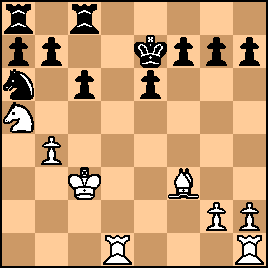
click for larger viewThe readings on the clock reflected the time and thought needed by both players to reach the above position: Reshevsky: 1:43
Smyslov: 1:37
Reshevsky now took 13 minutes to ponder the situation. The position was very likely a theoretical draw (or so the computers seem to say), but that was scant solace to the players who had to unravel the complexities of this highly difficult position. |
|
Feb-27-22
 | | KEG: <saffuna>What you say is of course true, but Kmoch's point is that--though Black had four pawns for the Bishop--his edge on each side of the board was only two pawns. Thus, it was difficult for him to make headway on either wing while--especially on the Queen-side--White could make use of his Bishop to harass the Black pawns. If, by contrast, Black had all of his pawns on the King-side (e.g., make his b-pawn an e or f-pawn) then Black would have had a formidable pawn mass which might have been a major problem for White. As it was, Reshevsky had all sorts of chances to nab pawns and meticulous defense by Smyslov was essential. |
|
Feb-27-22
 | | KEG: Post VIII
23. Kb3
"?"--(Keres)
All of the commentators agreed that this was not best. The idea, as Golombek noted, was to be able to threaten with b5 (without a discovered check). But Reshevsky's winning chances were now fading. Kmoch favored 23. Nb7, but, as Keres and Golombek correctly retorted, 23...Nxb4 (much better than 23...Rab8) seems sufficient for Black to hold. But here Keres and Golombek only considered 24. Nd6 after which Black draws with 24...Rcb8 (much better than 24...Nd5+ as given by Keres and Golombek) and ignore 24. Kxb4 which makes Black work a little harder (24...Rab8 [forced] 25. Rb1 RxN+ 26. Kc5 Rb5+ 27. RxR cxR+ 28. Kxb5 f5 29. Ra1, though the game will likely still be drawn. The best try, however, is 23. Ra1, the merits of which divided the commentators. Keres said it wins; Golombek said it gives "good winning prospects," while Euwe said it is doubtful that "White will be able to undertake much" against best defense with this move. In fact, all of these usually superb commentators mistakenly assume that Black would respond to 23. Ra1 with 23...Rab8, which in fact loses. The only saving move would be 23...Nc7 (24. Nxb7 Nd5+ 25. Kd3 [25. Kd2 was no better] Nxb4+ 26. Kc4 Rcb8 27. KxN RxN+ after which White is better but no win is in sight. In sum, and contrary to what Keres insists, Reshevsky did not miss a win here. After 23. Kb3, the position was:

click for larger view23... Rab8
Although not mentioned by anyone, 23...Rc7 would probably have been simpler and better. 24. Ra1
24. b5? would be bad and would shift the advantage to Black not because of 24...Nc7 (as Golombek claimed) but because of 24...cxb5! 25. Nxb7 (pretty much forced) Rc4 and suddenly Black is in command with his two passed pawns on the Queen-side and his active Rook on c4. Reshevsky did well not to go down this rabbit hole. 24... f5
"?"--(Keres)
"!"--(Kmoch)
"...the text-move weakens the e6-pawn and thus gives White the opportunity to win a pawn on the queen-side without giving Black the opportunity to exchange the b-pawn." (Keres) By contrast:
"While White concentrates his forces on the Queen-side, Black prepares for the saving counter-action on the other wing." (Kmoch) Both 24...f5 and 24...Rc7 (and indeed 24...Nc7) all have their points. In any case, White would have winning chances. Keres went on to recommend 24...Rc7. But, while probably best, in fact White would still be better after 25. Nxc6+ bxN 26. RxN c5 27. Rha1 Rxb4+ 28. Kc3 f5 29. RxR RxR 30. RxR+. After 24...f5, the position was:

click for larger viewIt was here that most commentators claimed that Reshevsky missed his last real chance to try for a win. I will consider the merits of these claims in my next post on this game. As I will attempt to show, much of the analysis of this position is based on a mistake. Yes, Reshevsky was still better, and maybe he had winning chances. But the move favored by most of the commentators (25. Rhe1) was not the way to win, if indeed there was such. |
|
Feb-27-22
 | | KEG: Post IX
I should point out that prior to Reshevsky's 25th move, the clocks read: Reshevsky: 2:06
Smyslov: 1:50
25. Rhcc1
"?"--(Keres)(Golombek)(Euwe)(Wade-Whiteley-Keane) While Keres' statement that the text enabled Smyslov to obtain "complete equality" is an overstatement, it is certainly correct to say that Reshevsky's winning chances were theoretically gone after this second-best move. Euwe perhaps put it best: "White is letting his best chance slip through his fingers." The question is: what was best here?
All of the commentators contended that Reshevsky should have played 25. Rhe1. And they were all wrong. Much ink has been spilled in analyzing 25. Rhe1 here, and a myriad of possible responses have been examined often in minute detail. It has been shown that 25...Kf7 and 25...Rc7 lose, and that 25...Kf6 gives Black at best a very tenuous position. But the correct and saving move is 25...Nc7. Keres, for example, claimed that after 25...Nc7 26. Bxc6 wins. But in fact, Black draws here with 26...bxB 27. Nxc6+ Kf6 28. NxR RxN 29. Rxa7. While Golombek, for example says that the resulting position is a win for White, contrary to what Golombek contends, 29...Nd5 30. Ra4 is not a win for White. The position would then be: 
click for larger viewYes, White is up the exchange for a pawn, but, contrary to Golombek, Black here should not play 30...Nb6? (which does indeed lose to 31. Ra6 as Golombek notes) but instead just push his King-side pawns. In every variation I have tried, Black now draws with either 30...f4 or 30...g5. Thus, the supposedly winning 25. Rhe1 is no better than Reshevsky's actual move. The only legitimate winning chance is the move dismissed by the commentators: 25. Nxc6+. Then, after 25...bxN 26. RxN c5 Black has anything but an "easy draw" (Golombek) after 27. Re1! If then 27...Rxb4+ 28. Kc3 Rb6 (best), Black would still face a grinding task following 29. Rxa7+ Kf6 (forced) 30. Rd1 which would leave: 
click for larger viewI am by no means claiming that White wins here, but White's pieces are powerfully posted and Black will have to struggle to reach a draw. Giving all of the above, and since Reshevsky was facing time trouble, it is unfair to criticize his move as all the commentators did when their own choice with all the time in the world to analyze was no better (and probably gave even lesser chances to win than did Reshevsky's move. Let us now return to the actual game after Reshevsky's much critiqued 25. Rhc1: 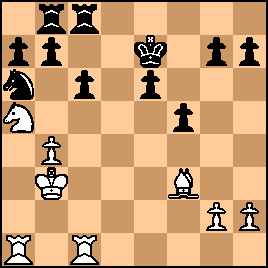
click for larger view25... Kf6
Holding the position from this point was hardly the piece of cake the commentators claimed it was. For starters, the plausible looking 25...Nc7 loses, as Golombek noted. He gives the winning line for White from here as 26. Bxc6 bxB 27. Nxc6+ Kd6 28. NxR RxN 29. Rxa7 Nd5 30. Rxg7. But in fact this last move blows the win for White (30...Rxb4+ 31. Kc2 h5 (or 31...Rh4) and Black with a pawn for the exchange and a protected passed pawn has excellent chances to hold. The winning move in this line after 25...Nc7? is 30. Rc4! Probably best for Black here is 25...Rc7, a move nobody mentions. Smyslov's 25...Kf6 was also probably sufficient to save the game, but it required a bit more work for Black, the position now being: 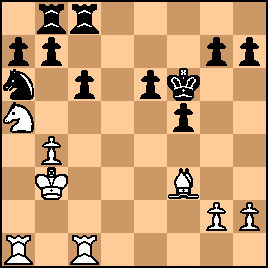
click for larger view |
|
Feb-28-22
 | | perfidious: <KEG>, for Reshevsky to have 24 minutes left to reach the haven of move 40 qualifies as oceans of time by his standards. (laughs) |
|
 |
|
< Earlier Kibitzing · PAGE 1 OF 2 ·
Later Kibitzing> |
|
|
|





